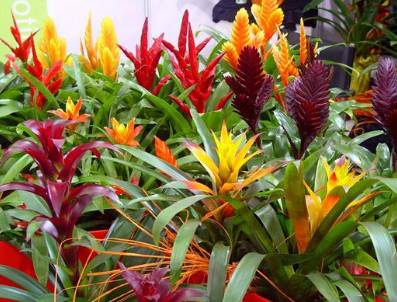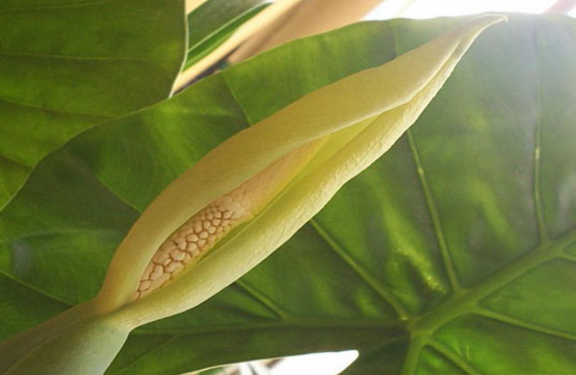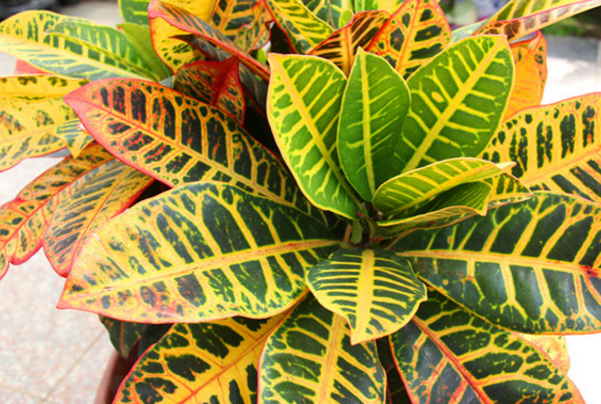Is good luck poisonous? what if the leaves turn yellow and curl?
Many flower friends will bring good luck at home. Not only because of the auspicious meaning of this plant name, but also because of its colorful colors with long green leaves, it makes people have a special amorous feelings. Today, the editor will take you to learn something about good luck.

Is good luck poisonous at the moment?
As to whether good luck is poisonous, there are two voices, most people think that it is non-toxic, and a small number of people think it is poisonous. Take a look at the specific statement.
1. Good luck is non-toxic
The head of good luck is what we often call pineapple, but there is no fruit, which is no different from eating pineapple. To say that it is poisonous, people who love to eat pineapples and people living in the tropics are deeply poisoned.
Isn't it a good proof that good luck is such a popular indoor plant now? At least so far, no flower friends or florists have come forward and said: Hongyuan is poisonous. True knowledge comes from practice, and the personal maintenance experience of flower friends speaks for itself.
2. Good luck is poisonous
It is said that flowers and plants such as Hongyudangtou and Datura are subtropical plants in the south, and the extract from their leaves and stems is the embryonic form of anesthetics. The oxygen produced by its light and action contains a small amount of alkaloids (strong alkaloids). A little longer time, will produce dizziness, nausea and other symptoms. Planting for a long time will have hallucinogenic, hand and foot paralysis and other symptoms. Therefore, this kind of ornamental plant is absolutely not suitable for indoor planting.
3. Summary
Poisonous and non-toxic, of course, depends on science. It is right that good luck is poisonous, because in the tropics, in certain wild environments, the photosynthesis of Hong Yun will produce alkaloids. However, after leaving the country of origin and moving into people's families, the environment will change greatly, and the content of this alkaline substance will be reduced, which will basically not affect people's health.
After scientific verification, Hongyun does have a certain degree of toxicity, but timely ventilation in family maintenance will not cause harm to the human body.
What if the leaves turn yellow and curl?
In the case of lucky luck when the leaves turn yellow or curly, consider whether it is caused by one or more of the following factors.
1. The temperature is too high or too low
Hongyun lives in a warm and humid environment. The suitable temperature for growth is 21-28 ℃ during the day and 18-21 ℃ at night. The highest temperature can not exceed 35 ℃.
High temperature is disadvantageous to the growth of Hongyundang, but in the environment of 10 ℃ for a long time, it is also easy to cause plant growth retardation, leaf or bract turning red, white discoloration and so on. At this time, antifreeze and cold protection agents should be sprayed to prevent the plant from dying as the temperature continues to drop.
2. Overwatering or insufficient watering
Although Hongyun likes the moist environment, it can keep the basin soil moist on weekdays, and it is generally not watered on rainy days. It is best to use dried water for family care rather than directly watering it with tap water.
Hongyun is a flower that can enjoy both flowers and leaves. It is best to spray water on the leaves once a day to remove dust and make the leaves bright. at the same time, it is also conducive to photosynthesis and promote the healthy growth of plants.
If watered too much, the basin soil will be too wet for a long time, which will cause lack of oxygen in the soil and eventually lead to rotting roots. Because it hinders the normal respiration and the absorption of water and nutrients, it will cause the leaves to turn yellow and fall off. After the injury, the young leaves become light yellow, and then the old leaves gradually turn yellow. in this case, watering should be controlled immediately, fertilization should be suspended, and the soil should be often loosened to make the soil well ventilated.
However, if the water is missed or half of the waist water is watered for a long time (that is, the upper part is wet and the lower part is dry), it will affect the nutrient absorption, and it is also easy to cause the leaves to be dull and dull, and the leaves wilt and droop. First, the lower old leaves aged, and gradually withered and yellowed off from the bottom up. At this time, a small amount of watering and spraying is needed to gradually recover and then turn to normal watering.
The air humidity should be high, and it is best to keep it at 75-85%. When the plant growth is less than 50%, the plant will shrink leaves and curl.
3. Improper fertilization
The flowering period of Hongyun is in winter, and sufficient fertilizer is required during flowering. Dilute organic liquid fertilizers such as bean cakes and sesame sauce dregs (20% concentration) are usually applied every two weeks, or soybeans or fermented rice washing water can be used.
When fertilization is insufficient, there will be a lack of nitrogen and other nutrients in the basin, resulting in thin branches and leaves, thin and yellow leaves. It is necessary to pour the pot in time and gradually apply rarefied mature liquid fertilizer or compound flower fertilizer into new loose and fertile culture soil. If the fertilizer is too much, the new leaves will be thick and uneven, and the old leaves will fall off. At this time, we should immediately stop fertilization, increase the amount of water, make fertilizer flow out of the drainage hole at the bottom of the basin, or immediately pour the basin, rinse the mound with water and then plant it again into the basin.
4. The illumination is not up to standard
To make the leaves bright and blossom regularly, light is very important. In winter, there should be at least 4 to 5 hours of direct sunlight every day. In case of cloudy and rainy days, lights can be used to increase the light. In summer, the seedling pot should be placed in the shade, and indoor cultivation can also be set up as a shade net.
5. Soil quality
Good luck is suitable for the growth of loose, fertile and humus soil. In family cultivation, peat soil can be mixed with 2 parts of peat soil and 1 part of fine sand to prepare culture soil. Generally, the soil bought from the flower market is suitable for plant growth. When you add soil to it later, you should pay attention to the soil quality.
6. Improper prevention and control of diseases and insect pests
Good luck in the temperature or humidity is too high, poor ventilation in the environment, prone to disease and insect damage, at this time, the leaves are also prone to yellowing or curling signs. However, if the concentration of pesticides is too high in the prevention and control of diseases and insect pests, or it is polluted by toxic gases in the atmosphere, or cold water is suddenly irrigated when the temperature is high, it is easy to cause the leaf tip or leaf surface to turn yellow and scorch, or even the whole plant to die. Therefore, we should pay attention to the rational use of pesticides and try to eliminate air pollution sources.
7. The position is not suitable.
The head flower of Hongyun tries to avoid putting it next to the air conditioner or the TV set. Excessive radiation may also cause pathological changes in its leaves.
In addition, some friends found that good luck is not popular at the moment. The florescence of good luck is usually in winter and spring. If the flowering season is over, it is normal for the flowers in the middle to become lighter and wither. In this case, you can cut off the heart in the middle, cultivate the lateral buds around the old seedlings, and when they grow to how long, gently break them off with your hands and reinstall the basin (with Xiaopeng, humus or peat soil). After that, pay attention to the heart of the leaf when watering, and the heart of the leaf is full.
The head of good luck is indoor ornamental flowers in winter and spring, which are evergreen all the year round, with beautiful and colorful inflorescences, but do not rule out situations such as yellowing or curling of leaves. When you encounter such problems, check the above causes to see if you can solve the situation of yellowing (curling) of leaves at the moment of good luck.
- Prev

The reasons for the yellowing of Guanyin leaves in dripping water and what are the advantages of planting them
The appreciation value of Dishui Guanyin lies in its luxuriant and verdant leaves. When watering or air humidity is high, water droplets will drop from the edge of the leaves, which is very agreeable. Let's learn more about Dishui Guanyin.
- Next

Is sprinkling golden banyan poisonous? what if the leaves fall off?
The larger ornamental plant, the golden banyan, has a very warm name, just like the sun shining down, so the plant itself is colorful. Today we are going to appreciate Sajin Rong, which has the name of sunshine. Is sprinkling golden banyan poisonous? sprinkling golden banyan poisonous, sprinkling golden banyan, Euphorbiaceae shrub plant, its branches are small
Related
- Fuxing push coffee new agricultural production and marketing class: lack of small-scale processing plants
- Jujube rice field leisure farm deep ploughing Yilan for five years to create a space for organic food and play
- Nongyu Farm-A trial of organic papaya for brave women with advanced technology
- Four points for attention in the prevention and control of diseases and insect pests of edible fungi
- How to add nutrient solution to Edible Fungi
- Is there any good way to control edible fungus mites?
- Open Inoculation Technology of Edible Fungi
- Is there any clever way to use fertilizer for edible fungus in winter?
- What agents are used to kill the pathogens of edible fungi in the mushroom shed?
- Rapid drying of Edible Fungi

